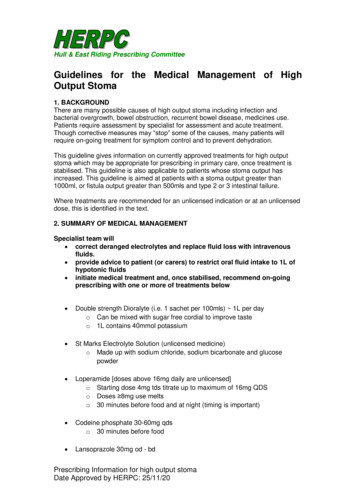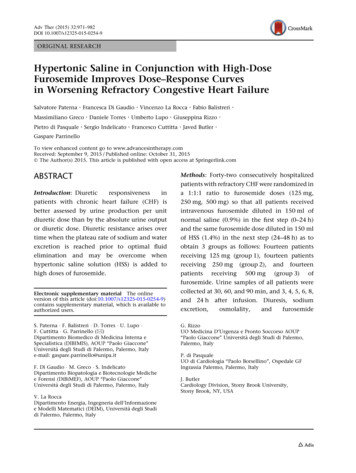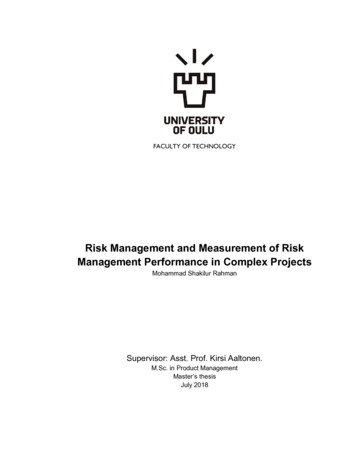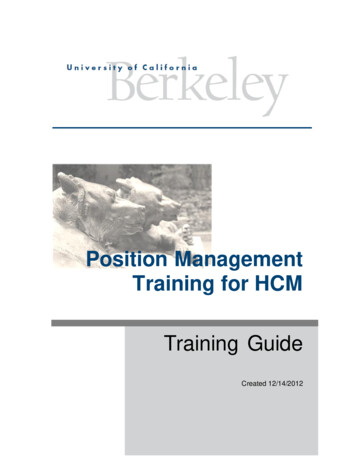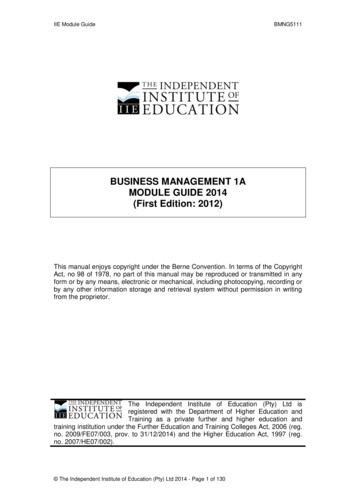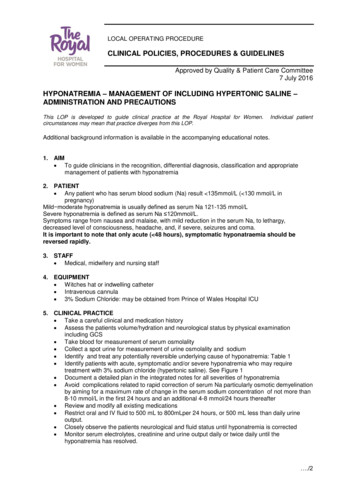
Transcription
LOCAL OPERATING PROCEDURECLINICAL POLICIES, PROCEDURES & GUIDELINESApproved by Quality & Patient Care Committee7 July 2016HYPONATREMIA – MANAGEMENT OF INCLUDING HYPERTONIC SALINE –ADMINISTRATION AND PRECAUTIONSThis LOP is developed to guide clinical practice at the Royal Hospital for Women.circumstances may mean that practice diverges from this LOP.Individual patientAdditional background information is available in the accompanying educational notes.1. AIM To guide clinicians in the recognition, differential diagnosis, classification and appropriatemanagement of patients with hyponatremia2. PATIENT Any patient who has serum blood sodium (Na) result 135mmol/L ( 130 mmol/L inpregnancy)Mild moderate hyponatremia is usually defined as serum Na 121-135 mmol/LSevere hyponatremia is defined as serum Na 120mmol/L.Symptoms range from nausea and malaise, with mild reduction in the serum Na, to lethargy,decreased level of consciousness, headache, and, if severe, seizures and coma.It is important to note that only acute ( 48 hours), symptomatic hyponatraemia should bereversed rapidly.3. STAFF Medical, midwifery and nursing staff4. EQUIPMENT Witches hat or indwelling catheter Intravenous cannula 3% Sodium Chloride: may be obtained from Prince of Wales Hospital ICU5. CLINICAL PRACTICE Take a careful clinical and medication history Assess the patients volume/hydration and neurological status by physical examinationincluding GCS Take blood for measurement of serum osmolality Collect a spot urine for measurement of urine osmolality and sodium Identify and treat any potentially reversible underlying cause of hyponatremia: Table 1 Identify patients with acute, symptomatic and/or severe hyponatremia who may requiretreatment with 3% sodium chloride (hypertonic saline). See Figure 1 Document a detailed plan in the integrated notes for all severities of hyponatremia Avoid complications related to rapid correction of serum Na particularly osmotic demyelinationby aiming for a maximum rate of change in the serum sodium concentration of not more than8-10 mmol/L in the first 24 hours and an additional 4-8 mmol/24 hours thereafter Review and modify all existing medications Restrict oral and IV fluid to 500 mL to 800mLper 24 hours, or 500 mL less than daily urineoutput. Closely observe the patients neurological and fluid status until hyponatremia is corrected Monitor serum electrolytes, creatinine and urine output daily or twice daily until thehyponatremia has resolved. ./2
2.LOCAL OPERATING PROCEDURECLINICAL POLICIES, PROCEDURES & GUIDELINESApproved by Quality & Patient Care Committee7 July 2016HYPONATREMIA – MANAGEMENT OF INCLUDING HYPERTONIC SALINE –ADMINISTRATION AND PRECAUTIONS cont’d Acute ( 48 hours duration), symptomatic and/or severe hyponatremia is a medicalemergencyInitiate PACE Tier 2Notify the Anaesthetic fellow, Physician on call /- referral to POW ICU or nephrologist.Discuss treatment plans with the Acute Care Nurse in charge and the bed manager astransfer to ACC or POW ICU is mandatory for these patients.Be aware that harm often follows inappropriate or rapid treatment of hyponatraemia inasymptomatic patients.Refer to the following guide for rapid correction:Aim to acutely raise the serum sodium concentration by 4 to 6 mmol/L to prevent neurologicaldamage secondary to brain herniation, swelling and cerebral ischaemia.Rapid correction of hyponatremia requires critical care monitoring ie HR, BP, RR, Oxygensaturation, neurological observations including GCS and strict fluid balanceAn estimate of the required volume of 3% sodium chloride (hypertonic saline ) may bedetermined using the formula and calculations in Appendix A.Administer 3% sodium chloride (hypertonic saline ) 150 mL IV over 20 minutes via infusionpumpDiscard remaining 3% sodium chloride and infusion line after 150mL administered.Recheck serum sodium every 2 to 4 hours depending on GCS and clinical status scoresRepeat infusion as needed up to a maximum of 3 infusionsCease 3% sodium chloride infusion when either of the following three criteria are met:o symptoms improveo target increase in serum sodium has been achievedFluid restrict the patient to maintain the serum sodiumOral sodium chloride tablets may be useful6. DOCUMENTATION Integrated Clinical Notes NSW health fluid order chart NSW health fluid balance chart GCS score chart7. EDUCATIONAL NOTESBackground:The normal range of the serum or plasma sodium concentration is 135 to 145 mmol/L.In pregnancy, the lower limit of normal is 130mmol/L.Hyponatraemia, defined as a serum sodium (Na) concentration 135 mmol/L [ 130 mmol/L inpregnancy], is the most common disorder of body fluid and electrolyte balance encountered in clinicalpractice. It can lead to a wide spectrum of clinical symptoms, from subtle to severe or even lifethreatening, and is associated with increased mortality, morbidity and length of hospital stay in patientspresenting with a range of conditions. It is usually associated with a reduction in effective plasmaosmolality i.e. hypotonic hyponatremia.Hyponatraemia is NOT primarily a disorder of SODIUM but a disorder of water balance. Whether thepatient is hypovolaemic or euvolaemic there is a relative excess of body water compared to total bodysodium and potassium content. True hyponatraemia is always associated with either an appropriate orinappropriate activation of the hormone vasopressin (also called antidiuretic hormone). /3
3.LOCAL OPERATING PROCEDURECLINICAL POLICIES, PROCEDURES & GUIDELINESApproved by Quality & Patient Care Committee7 July 2016HYPONATREMIA – MANAGEMENT OF INCLUDING HYPERTONIC SALINE –ADMINISTRATION AND PRECAUTIONS cont’dClassificationPseudohyponatraemia is a laboratory artefact that occurs when abnormally high concentrations oflipids or proteins in the blood interfere with the accurate measurement of sodium. Serum osmolalitywill be within the normal range in case of pseudohyponatraemia and direct measurement of sodiumusing a blood gas analyser will yield the true sodium concentration.Isotonic hyponatraemia: In the majority of patients that present with hyponatraemia, the serum ishypotonic i.e. both the sodium concentration and the effective osmolality are low. Sometimes, theserum contains other osmoles that may effectively replace sodium to produce isotonic (isosmotic)hyponatraemia. Initially when these osmoles are added to sodium they increase osmolality, “attracting”water from the intracellular compartment: water actually moves from a higher concentration insidecells to the now relatively reduced concentration in the extracellular space. This then reduces theserum sodium concentration until the osmolalities in the two compartments are equalised. Examplesof such osmoles include glucose (hyperglycaemia due to uncontrolled diabetes mellitus), mannitol andglycine (absorption of irrigation fluids during urological or gynaecological surgery).Hypertonic hyponatraemia: In hyperglycaemia-induced hyponatraemia, hyponatraemia is similarlycaused by dilution due to hyperosmolality but there is such a rapid excess of the additional osmolesthat there is insufficient time for equilibration and, in any case, water is continuously lost through theosmotic diuresis caused by the hyperglycaemia.It is important to distinguish between measured osmolality and calculated osmolality which is all that isprovided unless measured osmolality is specifically requested.When SIADH persists long term (often when it is due to cerebral or pulmonary abnormalities ormalignancy), first-line therapy is chronic fluid restriction, usually restricting intake to 1 litre daily.Sodium chloride 600mg tablets may also assist in some patients.When this is insufficient, specialist (nephrology or endocrine) assistance should be sought.Clinical classification (see Table 1)Hyponatraemia cannot be maintained without ADH activity leading to distal tubular water reabsorption.Thus all cases of hyponatraemia have a relative or absolute excess of ADH activity.A clinical estimation of hydration status is ESSENTIAL before the cause can be determined and guidetherapy. This will determine whether the patient is hypo-, eu- or hypervolemic.Excretion of water may be impaired in older people or by pain and nausea. It is also impaired byinadequate plasma volume eg blood loss, low cardiac output eg cardiac failure or shock and kidneyimpairment, as well as inadequate glucocorticoid and thyroid function. These possibilities must beexcluded before diagnosing the syndrome of inappropriate secretion of antidiuretic hormone (SIADH).Clinical diagnosis of hyponatremia-see Figure 1.The syndrome of inappropriate secretion of antidiuretic hormone (SIADH)SIADH has diverse causes. These most commonly relate to intrathoracic or intracranial pathology,malignancy or drugs that can impair water excretion.SIADH cannot be diagnosed in the presence of diuretic use, hypothyroidism orhypocortisolaemia . ./4
4.LOCAL OPERATING PROCEDURECLINICAL POLICIES, PROCEDURES & GUIDELINESApproved by Quality & Patient Care Committee7 July 2016HYPONATREMIA – MANAGEMENT OF INCLUDING HYPERTONIC SALINE –ADMINISTRATION AND PRECAUTIONS cont’dSIADH is likely when the following results apply. serum sodium concentration lower than 130 mmol/L serum osmolality lower than 275 mmol/kg urine osmolality higher than 100 mmol/kg and usually higher than serum osmolality urine sodium concentration higher than 30 mmol/L.The diagnosis can generally be established from the clinical context and the relationship betweenurine and serum osmolality, which should be assessed in concurrent samples. Assaying plasmaantidiuretic hormone (ADH) is not required. Serum urea, uric acid and potassium concentrations areoften low.Treating hyponatremiaIn general, treatment is dependant on the chronicity, the underlying cause, the clinical and biochemicalseverity and the patient’s co-morbidities. Harm often follows inappropriate or rapid treatment ofhyponatraemia in asymptomatic patients.Only acute ( 48 hours), symptomatic hyponatraemia should be reversed rapidly. If in doubt,assume the hyponatraemia is chronic.Always identify and treat any underlying cause in addition to direct treatment for hyponatremiaIn general, 0.9% sodium chloride is not helpful in euvolaemic hyponatraemia and will usually worsenhyponatraemia in SIADH. This is because the sodium will be lost in the urine whilst the water will beretained in proportion to the urine:plasma osmolality ratio.Recommendations for treatment by volume statusHypovolaemic hyponatraemia :Volume depleted patients may require resuscitation. Any drugs implicated as a cause of hypovolaemichyponatraemia should be stopped before intravenous treatment begins.Clear-cut sodium and water depletion e.g. from diuretic drugs may respond to intravenous 0.9%sodium chloride, with potassium supplements if required. Careful observation is required.If hyponatraemia is severe or chronic, boluses (250 mL) of sodium chloride 0.9% followed by frequent(2 to 4 hourly) assessment of sodium and water balance are safer than continuous infusion, sincerapid correction can depress ADH and lead to sudden massive diuresis and an overly rapid increase insodium.Hypervolaemic hyponatraemia:Patients who are oedematous due to heart, liver or kidney failure should be treated with fluidrestriction. A loop diuretic may be added as long as the effective intravascular volume is not depletedfurther.Euvolaemic hyponatraemia:Treatment will depend on: presence of central nervous system symptoms eg unconsciousness, seizure, drowsiness,headache severity rate of development. ./5
5.LOCAL OPERATING PROCEDURECLINICAL POLICIES, PROCEDURES & GUIDELINESApproved by Quality & Patient Care Committee7 July 2016HYPONATREMIA – MANAGEMENT OF INCLUDING HYPERTONIC SALINE –ADMINISTRATION AND PRECAUTIONS cont’dAcute: severe symptomatic hyponatraemia generally needs treatment with intravenous sodiumchloride 3%.Chronic: or slowly developing hyponatraemia of the same degree should be managed by fluidrestriction.Recommendations for treatment by severity of hyponatremiaMild to moderate hyponatraemia MAY BE MANAGED ON THE WARDFor mild to moderate hyponatraemia in euvolaemic or hypervolaemic patients (serum sodiumconcentration from 120 to 135 mmol/L with no cerebral symptoms): Fluid restrict: 500 mL to 800mLper 24 hours, or 500 mL less than daily urine output.Monitor serum electrolytes, creatinine and urine output daily or twice daily.More aggressive intervention to increase the serum sodium concentration above 120 mmol/L isgenerally not indicated.Severe hyponatraemia ADMIT TO ACC or ICUFor severe hyponatraemia (serum sodium concentration 120 mmol/L or with cerebral symptoms),treatment is intravenous 3% sodium chloride (513 mmol/L). The initial target serum sodiumconcentration should not be higher than 120 mmol/L.Rapidly correcting hyponatraemia may produce permanent central nervous system injury, due toosmotic demyelination.Patients with chronic hyponatraemia (ie known duration more than 48 hours) are particularly at risk.Additional factors that increase this risk include: serum sodium concentration lower than or equal to 105 mmol/L hypokalaemia alcoholism malnutrition advanced liver disease.To avoid osmotic demyelination, the maximum rate of change in the serum sodium concentration inchronic hyponatraemia should be: not more than 8-10 mmol/L in the first 24 hours and an additional 8 mmol/24 hours thereafterTo reduce the risk of overcorrection, the initial goal of therapy can be even lower: 4 to 8 mmol/L daily.For patients with the additional risk factors listed above, the goal should be 4 to 6 mmol/L daily.This infusion should be given with critical care monitoring i.e. HR, BP, strict fluid balance and dailyweighs.More rapid initial correction can be considered in patients with: seizures or coma, regardless of whether the hyponatraemia is known to be chronic self-induced acute water intoxication (e.g. psychiatric conditions, endurance exercise) known hyponatraemia for less than 24 to 48 hours intracranial pathology or increased intracranial pressure. ./6
6.LOCAL OPERATING PROCEDURECLINICAL POLICIES, PROCEDURES & GUIDELINESApproved by Quality & Patient Care Committee7 July 2016HYPONATREMIA – MANAGEMENT OF INCLUDING HYPERTONIC SALINE –ADMINISTRATION AND PRECAUTIONS cont’dThe goal of therapy in these patients is to raise the serum sodium concentration by 4 to 6 mmol/L, toprevent neurological damage secondary to brain herniation, swelling and cerebral ischaemia. Use: 3% sodium chloride 150 mL IV over 20 minutes. recheck serum sodium every 2 to 4 hours depending on GCS and clinical status scores repeat as needed up to a maximum of 3 infusions and cease 3% sodium chloride infusionwhen either of the following three criteria are met:o symptoms improveo target increase in serum sodium has been achieved fluid restrict the patient to maintain the serum sodium oral sodium chloride tablets may be usefulOften it is difficult to assess whether severe hyponatraemia is acute or chronic. Unless it is clearlyacute, a slower rate of correction is essential. The volume of bolus sodium chloride and the patient'sresponse must be considered when calculating the remaining volume and infusion rate in chronichyponatraemia.8. RELATED POLICIES / PROCEDURES / CLINICAL PRACTICE LOP Acute Care: Admission Criteria, Process and Management Guideline Catheterisation Potassium – Administration of Oral or Intravenous9. RISK RATING High10. NATIONAL STANDARD Medication safety11. REFERENCES Spasovski G, Vanholder R, Allolio B, Annane D, Ball S, Bichet D, et al. Clinical practiceguideline on diagnosis and treatment of hyponatraemia. European Journal of Endocrinology.2014;170(3):G1-G47. Moulds R, Black K, Clearihan L, Ebeling P, Frauman A, Greenberg P, et al. EndocrinologyExpert Group. Therapeutic Guidelines: endocrinology. Version 5. 2014.REVISION & APPROVAL HISTORYEndorsed Therapeutic & Drug Utilisation Committee 18/2/16FOR REVIEW : JULY 2018 ./ Table 1Figure 1Attachment A
LOCAL OPERATING PROCEDURECLINICAL POLICIES, PROCEDURES & GUIDELINESApproved by Quality & Patient Care Committee7 July 2016HYPONATREMIA – MANAGEMENT OF INCLUDING HYPERTONIC SALINE –ADMINISTRATION AND PRECAUTIONS cont’dTable 1: Clinical classification of causes of hyponatremiaVolume statusHypervolaemia(“wet”)EuvolaemiaCause of low serum sodium concentrationheart failureliver cirrhosiskidney failurenephrotic syndromeSIADHdrug induced (eg carbamazepine, SSRIs, SNRIs)cerebral or pulmonary pathologymalignancy-associated (SIADH)Hypovolaemia (“dry”)hypothyroidismpsychogenic polydipsiapainnauseasurgery and anaesthesiaadrenal insufficiencysodium loss with free water intakevomiting and/or diarrhoeaburns*thiazides and related diuretic drugs (indapamide,hydrochlorothiazide, chlorthalidone)other sodium-wasting tic dilutionsevere hypertriglyceridaemia,hyperglycaemiamannitol or glycine administration (gynaecological andprostatic surgery)mechanism uncertain HIVSSRI selective serotonin reuptake inhibitor; SNRI serotonin and noradrenaline reuptake inhibitor
LOCAL OPERATING PROCEDURECLINICAL POLICIES, PROCEDURES & GUIDELINESApproved by Quality & Patient Care Committee7 July 2016HYPONATREMIA – MANAGEMENT OF INCLUDING HYPERTONIC SALINE –ADMINISTRATION AND PRECAUTIONS cont’dFIGURE 1
LOCAL OPERATING PROCEDURECLINICAL POLICIES, PROCEDURES & GUIDELINESApproved by Quality & Patient Care Committee7 July 2016HYPONATREMIA – MANAGEMENT OF INCLUDING HYPERTONIC SALINE –ADMINISTRATION AND PRECAUTIONS cont’dAppendix AThese calculations should be used as a guide to the total amount of 3% sodium chloride required butpatients do vary in their response and the most important aspect of management is frequentassessment of sodium and water balance including urine output as well as BP,PR and GCS.To calculate total body water:In women: Total body water (kg) body weight x 0.5 (nonelderly) or x 0.45 (elderly).Sample calculation:Patient: 60 kg, 40 years, femaleSerum sodium concentration: 110 mmol/LTarget serum sodium concentration at 24 hours: 118 mmol/LTo achieve an increase of 8 mmol/L calculate the total amount of 3% sodium chloride required in mLusing the equation below:Number of mmol to be increasedIncrease in serum sodium/litre ofInfused 3% sodium chloridex 1000813x 1000 615mL of 3% sodium chlorideTo achieve an increase of 8 mmol/L in 24 hours: infusion rate 615 mL 24 hours 26 mL/hourIf an initial rapid increase in the serum sodium concentration is needed, for example to achieve115 mmol/L of serum sodium in 6 hours, begin the infusion at 64 mL/hour for an anticipated 6 hours(to deliver 5 mmol) and then reduce to 13 mL/hour for the following 18 hours (to deliver the remaining3 mmol).If two bolus doses of 100 mL have been given initially, the remaining infusion volume over 24 hours is615 – 200 mL 415 mL, so the infusion rate 17 mL/hour.As a quick check of the calculation, the following conservative formula may be used to determine theinitial infusion rate (mL/hour) of 3% sodium chloride:
More aggressive intervention to increase the serum sodium concentration above 120 mmol/L is generally not indicated. Severe hyponatraemia ADMIT TO ACC or ICU For severe hyponatraemia (serum sodium concentration 120 mmol/L or with cerebral symptoms), treatment is intravenous 3% sodium chloride (513 mmol/L). The initial target serum sodium

